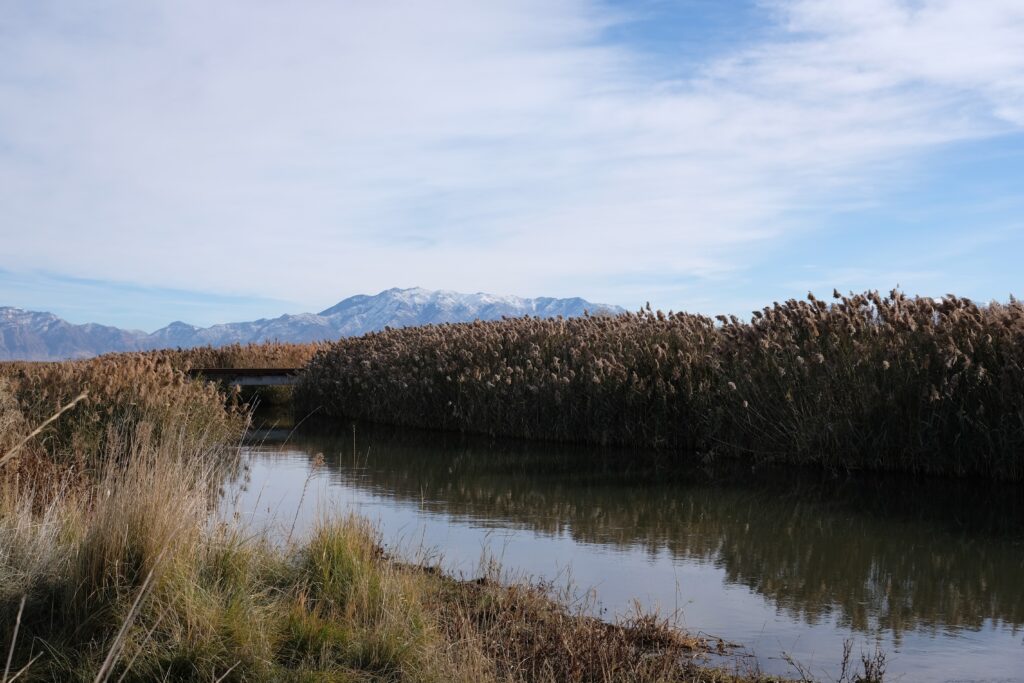
A tributary to the Great Salt Lake at the Ogden Bay Waterfowl Management Area is pictured on Monday, Nov. 25, 2024. The U.S. Geological Survey installed a stream gauge on this tributary, and 13 others, to monitory water flow into the Great Salt Lake. (Kyle Dunphey/Utah News Dispatch)
Although Utah lawmakers have taken a number of steps aimed at conserving and delivering more water to the Great Salt Lake, it’s difficult to measure whether those steps are actually making a difference.
That could change thanks to a $3 million investment from the federal government to install 13 new stream gauges positioned on the shores of the Great Salt Lake, measuring how much water is flowing into the beleaguered saline lake.
The $3 million comes from the U.S. Bureau of Reclamation and allows the U.S. Geological Survey, or USGS, to install and collect data around the Great Salt Lake for the next five years. USGS will also install buoys to measure water temperature, which will help predict future lake levels.
“This enhances our ability to measure the movement of water to the lake and into the lake. It also enhances our ability to monitor evaporation from the lake, salt concentration in the Great Salt Lake and better monitor ecosystems in the Great Salt Lake,” said David O’Leary, director of the USGS’ Utah Water Science Center.

In 2022, lawmakers passed some major changes to Utah water law, including HB33, which allowed the state to lease water from water rights holders in the Great Salt Lake basin. Instead of being used for irrigation or other uses, that leased water would flow to the lake.
It was seen as a major step in the right direction, moving away from the “use it or lose it” mantra that long dominated water rights in Utah. Until HB33, farmers, business owners and other landowners with a water right were often incentivized to use the entire amount of water allocated to them — if they didn’t, they risked losing their water right.
Now, HB33 allows the Utah Division of Forestry, Fire and State Lands to lease that water so the user doesn’t have to deplete it. But the state, lacking reliable data, doesn’t know exactly how much water it should lease. That will change with the installation of those 13 new stream gauges.
The state and federal government do currently have similar gauges in the Great Salt Lake basin tracking water flowing to the lake, but they are all far upstream. At the Ogden Bay Waterfowl Management Area, a 20,000-acre wetland on the shore of the lake, the nearest gauge is nearly 10 miles away in Plain City.
“There’s a lot of water use and a lot of water that can be coming in, between here and Plain City,” said Deputy Great Salt Lake Commissioner Tim Davis, speaking near one of the new stream gauges on Monday that measured flows on a slow-moving tributary emptying into Ogden Bay.
What policies could come from more reliable data? Funding, says Davis.

The new gauges will allow officials to better measure how much water is actually going to the lake and how much additional water is needed. If the gauges suggest current conservation steps aren’t enough, Davis can go to lawmakers, armed with the new data, to ask for more funding to lease additional water rights.
And although Davis said his office is not yet advocating for any major legislation this upcoming General Session, current data suggests the lake could use some help.
On Monday, lake levels hovered between 4,191 to 4,192 feet, which mirrors the start of 2021 — fueled by drought and excessive water use, lake levels continued to decline that year and into the next, hitting a historic low of 2,188.5 feet in November 2022.
Utah saw a historic amount of snow during 2023, and above-average levels in 2024, giving the lake a much needed boost and putting levels just below the “healthy” range of 4,198 to 4,205 feet. But since then, levels have again been in decline.
“The lake went up three feet and came down three feet. So, there’s a lot of work to do,” said Davis. “Everybody in the basin needs to conserve, dedicate and deliver water to the lake.”
YOU MAKE OUR WORK POSSIBLE.

